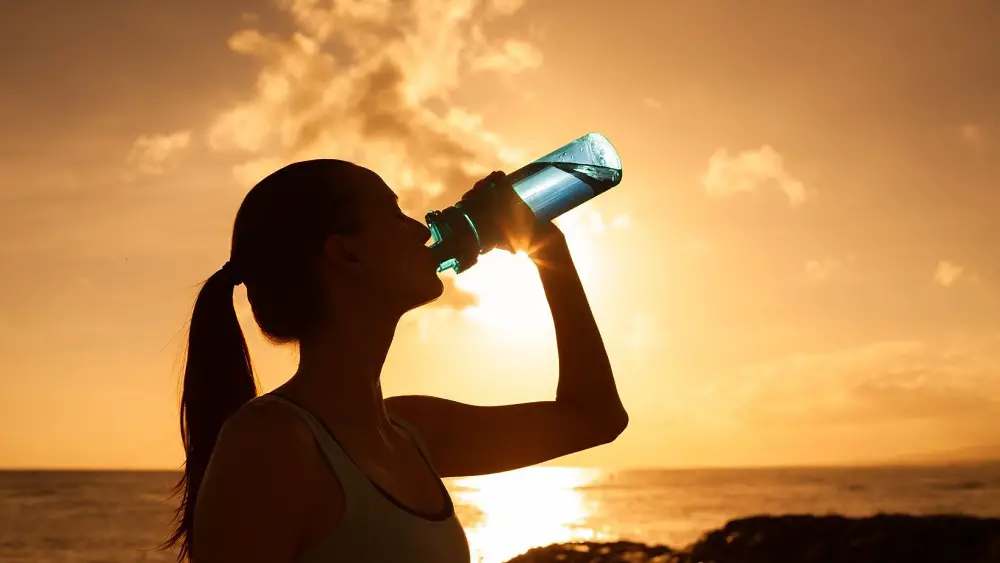One of the most important elements of exercise recovery is rehydration. It is vital to do this after strenuous activities that have made you sweat a lot, such as running, hot yoga, or weightlifting.
Sweat removes a lot of water from your body and you can quickly become dehydrated as a result. This can be very damaging to your health and can lead to other symptoms such as lethargy and headaches.

Every cell of the human body requires water to function. It assists with joint lubrication, blood circulation, regulation of your body temperature, and the removal of waste products to name a few. When you are dehydrated your body cannot function properly and this leads to poor health.
What Are The Symptoms Of Dehydration?
Dehydration can be caused by sweating, vomiting, diarrhea, or as a consequence of consuming diuretic medications. These are medications that promote the production and expulsion of urine from the body.
Some people are more prone to becoming dehydrated, such as people taking SSRIs (selective serotonin reuptake inhibitors), diabetics, people with kidney issues, children, and the elderly.
Some of the more easily recognizable symptoms of dehydration are being thirsty and having a dry mouth or skin. If you notice yourself needing to wee very infrequently, this could be an indication of dehydration.
If this is the case, look at the color of your urine and compare it to the chart below. This can tell you a lot about your body’s hydration.
Other common signs of dehydration are headaches, lethargy, fatigue, and dizziness.
Drinking Water
This is the cheapest, easiest, and often the most effective way to rehydrate. There are no additions included in water, meaning that you will not get any additional calories, fats, or sugars. It is an incredibly healthy drink choice and it is strongly recommended that you drink water consistently throughout the day. It is recommended that you drink about 8 cups of water daily to remain at optimal hydration levels.
Some people will lose a lot of salt in their sweat as well as water. If you notice your sweat stinging your eyes or you often get muscle cramps after exercising then this is you. It is important to replenish your body’s sodium levels too if these apply. Provided you eat a healthy and balanced diet, it is unlikely you will need to add sodium to your drinks.
Studies suggest that drinking larger amounts of water in one go helps to promote rehydration. This is because the water will move through your body at a faster rate, forcing gastric emptying to occur more quickly. This is when the fluids move through your stomach and small intestine to be absorbed into the bloodstream. The faster this happens, the faster you will rehydrate.
Fruits And Vegetables
The majority of fruits and vegetables have a water content of between 80 and 99% water. This makes them a nutritious and hydrating snack, perfect for a post-workout pick-me-up.
The most hydrating fruits include melons (particularly watermelon), berries, cucumbers, grapes, and oranges. Hydrating vegetable choices include spinach, lettuce, cabbage, and carrots.
Frozen fruits and vegetables are often more nutritionally dense than their fresh counterparts as their vitamins are locked in when frozen. They contain similar hydration levels too and are much more convenient to keep on hand.
A great way to get the hydration you need from fruits and vegetables is to blend them into a smoothie. Add in some coconut water, fruit juice, or plain water to promote the blending. For a more protein-laden smoothie, incorporate some Greek yogurt or milk too.
Drinking Milk
Milk contains a large number of electrolytes, which are essential for post-workout or post-illness recovery periods. We recommend drinking skim or low-fat milk as the fat levels can slow absorption into the bloodstream. If you are suffering from vomiting or diarrhea, fats are known to exacerbate these conditions.
Milk is also high in protein, making it perfect for muscular recovery. Many studies have shown that milk is as effective as consuming a sports drink at rehydration.
Eating Soup
Soups, especially broth-based soups, are a great way to boost your hydration levels. These will also contain sodium, which can help rebalance the electrolytes in your body. We would recommend making your own soups and broths, as commercially available versions are often incredibly high in sodium, which can further dehydrate you.
Oral Hydration Solutions
These are specially formulated solutions available from most drugstores over the counter. They are typically used to treat dehydration as a consequence of vomiting or diarrhea. Many people also use these solutions to prevent or alleviate the symptoms of hangovers.
These solutions have a water base and include a number of electrolytes and dextrose (a type of sugar). The most commonly incorporated electrolytes are chloride, potassium, and sodium. Some will also contain zinc or prebiotics.
These solutions can be expensive, but you can achieve the same results at home for a fraction of the cost. Combine a liter (34 ounces) of cool water with 6 teaspoons of sugar and a half teaspoon of salt. Stir until the sugar and salt have dissolved, before consuming.
If you find the taste unpleasant, we recommend adding in some flavor enhancers such as cordial or Kool-Aid. Be aware though that these will make the solution less nutritious as they will contain flavoring and coloring chemicals.
IV Drips
For a more extreme solution to dehydration, you may wish to consider inserting an intravenous drip. This allows a saline solution to be directed straight into your bloodstream. This solution often contains a number of vitamins and minerals that will be hugely beneficial to your recovery.
As the fluids enter the bloodstream directly, they can bypass the digestive system. This makes the rehydration process much more instantaneous. In cases of extreme dehydration, this is often the best solution.
Typically IV drips are only administered in hospitals by trained medical professionals. This is because it is a medical procedure and comes with a number of risks if done improperly.
